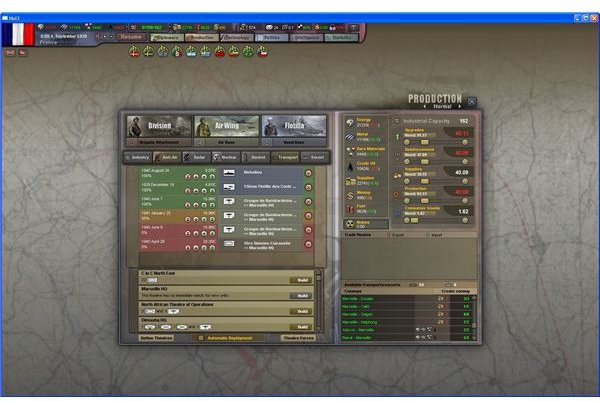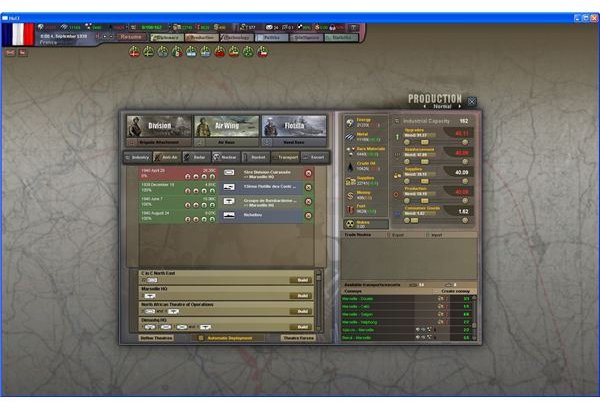Hearts of Iron III Strategy Guide - Production

Build Queue and Economy: All in one View
There is a lot to sink our teeth into here, so let’s start at the top left frame and work down. In the orange square (see screenshot) we have buttons to open menus to build land, air, and sea divisions. The three buttons beneath them, respectively: open menus to buy individual brigades, or air and navy bases. These allow you to command air and sea forces, which can only be operated within a certain range from their base. The seven buttons below access the building of non-traditional weapons, industry, convoys, and so on.
The yellow square is the main building queue, and below that, in the green square, are requests coming in from theatre commanders. We will describe these further later. For now, lets look at the right half of the window.
Economy Management in Hearts of Iron III

Starting at the top of the right half and working down, the column on the left (in the blue rectangle) shows our resources, supplies, money, fuel and their daily rates of change. The Nukes will stay at zero until you are pretty far along Hearts of Iron III’s massive tech tree.
In the top right of the frame (purple rectangle), just under where you can turn the AI on and off, are the oh so very important sliders discussed in detail below. The window panes at the bottom right (in a delightful pink, yup I’m running out of colours) have information about your trade routes and, below this, your convoys. Each of these is probably worth at least one article on their own, so for the purposes of this production guide we’ll let the Diplomacy and Convoy AI’s do their thing.
How Production Affects when You Get New Units in HoI III
Before we buy anything, lets check on our IC. We divvy it up with the five sliders. Upgrades gets newly researched tech to troops in the field. Reinforcement is used up by troops as they return to full strength over time. Supplies represents how many supplies you make for your troops domestically: these are stockpiled and can be bought and sold through diplomacy. Production is how much you are putting into the new projects in the large window on the left. Consumer Goods is the industrial production needed to keep dishes clean on the home front. Clicking the need button automatically sets the slider to that number.
The relationship between production and time of completion is important. The units in the production queue on the left have percentages which indicate the speed at which they are being built, which is a function of how much production each unit gets. The unit at the top of the queue is filled to 100% before production goes to the next unit. Green units are being built as fast as they can, yellow is underway, but not as fast as possible, and red means no work is underway.
That means that adding production won’t speed up the arrival of a unit that is already at 100%, and taking it away will nip its way up from the bottom of the list, first slowing those units, then the ones at the top.
Deciding which Hearts of Iron III Units to Build
You can either look around your forces, which we discuss in the next article, and decide what to build on your own, or there is a sort of semi-AI at work you can use. Theatre commanders will request more units, which show up at the bottom of the screen. Here we see that Command and Control for North Eastern France would please like 22 brigades of armour. Yeah… ya should’ve though of that before the Germans did. Marseille Head Quarters wanted three bomber wings and an armour brigade. Ok that we

can do.
Clicking the build button next to those requests will add them to the queue. We can see there are now an armour division and three bomber groups below the destroyer flotilla and battleship we were already working on when the Campaign started. There are two other things to notice. These units will automatically be deployed to the Marseilles HQ, which requested them, and our production need number shot up.
That is because the production need number is based on your entire production queue, and meeting the need would mean producing everything as fast as possible. Having extra items in the queue means that as economic factors change, you can just send any excess to production and not be wasting it.
Adjusting HoI III Production Priority

Hmm. There are Germans aplenty attacking the land border, and we are building battleships?
Canceling it would lose all the work we already got in on it, but we can lower the priority, keeping it on the backburner until we feel the need to flex some naval muscle. The little red downward double arrow will send the battleship to the back of the line.
It’s still green and says 100%, but that is because HoI III is paused. That’s actually preferable, since you can manipulate the queue until you are happy with it before any work gets done. For instance, the armour is probably the thing we will need soonest, so it goes up top via the double green arrow. Also, three bombers seems extravagant. We can delete two of them with the red Xs.
One armour division will not hold off the entire Blitzkrieg, so let’s customize a few more.
Building a Hearts of Iron III Division

Click on the Division Button. The menus to build air and sea forces work almost identically, and the base and other options are a lot simpler. We’ll go over the land divisions and the rest is easy from there.
There are some ready made templates for different unit types, but none of these immediately appeal to me. Also, if you are playing as a smaller nation, you may not have researched the ability to build the brigades needed for the division templates, in which case the Start Production button stays grey.
I want something I can keep in Paris and use to block any breakthroughs by the Germans. We mentioned earlier that C&C North East was desperate for some armour divisions, so that will definitely play a key role. Choosing a blank template from the top right, we then click armour in the list on the left three times.
Mixing in a motorized infantry brigade won’t slow us down at all, adds much more defensive ability, and will save some money. Click on it once. It also alters the softness rating (percentage of unarmoured vs armoured composition) of the division. A softness rating between 33 and 66% means the division gets a combined arms bonus, which will light up the softness icon. You can click Save Template under the template buttons if you will want to build more of these.
Serial or Parallel Unit Production
Parallel will put that many units in the queue immediately. Serial will repeat the process, adding a new division to the queue each time one is completed for the prescribed number of times. You can use both production settings together as well. For instance, 5 serial and 2 parallel will add a pair of divisions to the queue, and add another pair at the bottom of the queue each time the first two are done, four more times.
It may seem to make sense to just use lots of parallel production and manage the priorities in your queue to get what you need, but items added to the queue at a later date by a serial production run will benefit from any associated technology you researched in the meantime, so balance them out.
